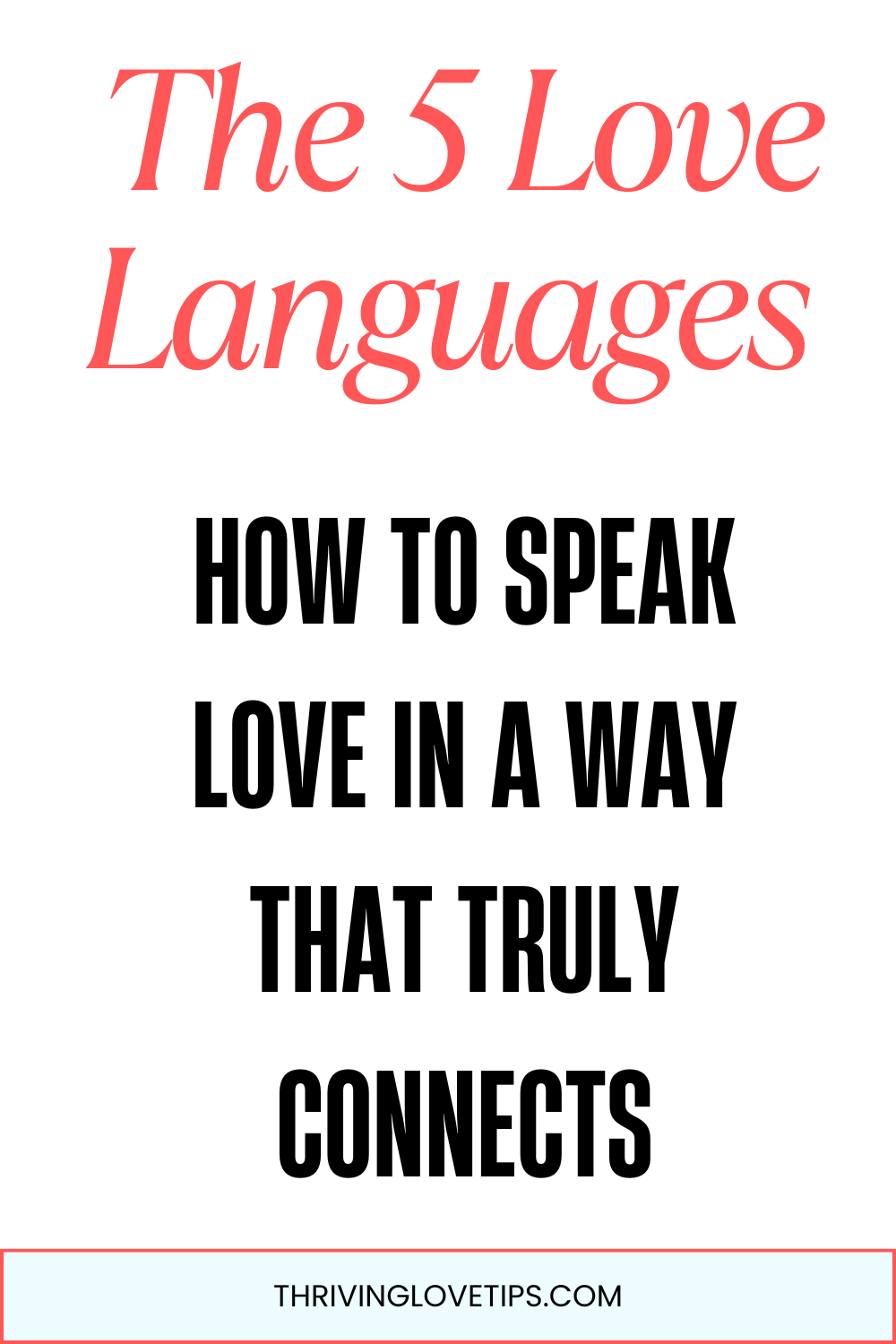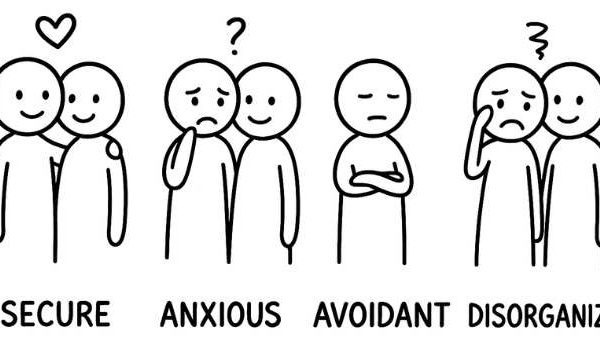Love is one of the most beautiful, complicated, and meaningful parts of our lives. It’s the glue that holds relationships together, the spark that makes life brighter, and the safe space where we can be our most authentic selves. But here’s the catch: as magical as love is, expressing it—and receiving it—doesn’t always come naturally. Sometimes, you feel like you’re pouring love into your partner, but they don’t seem to notice. Or maybe your partner showers you with affection, but it just doesn’t hit the way you hoped.
That’s where the concept of The 5 Love Languages comes in.
Dr. Gary Chapman, a marriage counselor and author, introduced this idea in his bestselling book The 5 Love Languages: The Secret to Love That Lasts. His theory is simple but life-changing: people give and receive love in different ways, and understanding these “languages” can completely transform your relationship.
Think of it like this: if you speak English but your partner only understands French, no matter how much you talk, your words won’t connect. The same goes for love. You could be expressing love in your language, but your partner may not “hear” it because their love language is different.
So, let’s break down the 5 Love Languages, how to recognize them in yourself and your partner, and how to use them to create a stronger, more fulfilling relationship.
Understanding Love Languages Changes Everything
Before we dive into the actual five, let’s talk about why this concept is such a game-changer. Relationships thrive on connection. But connection isn’t just about spending time together; it’s about feeling understood, valued, and loved in a way that resonates with you personally.
If your partner’s love language is Words of Affirmation, but all you ever do is buy them gifts, they may appreciate the gesture, but they might still feel unloved. On the flip side, if you crave Quality Time, but your partner only gives you compliments and no presence, you might feel unseen.
By learning to “speak” your partner’s love language (and teaching them yours), you’re not just showing love—you’re showing love in a way that lands. And that’s what deepens intimacy, builds trust, and keeps the spark alive.
The 5 Love Languages
Now, let’s go through each love language one by one.

1. Words of Affirmation
For some people, words are everything. They don’t just hear what you say, they feel it deeply. If this is your love language, kind words, encouragement, and verbal appreciation mean the world to you. Compliments, “I love you,” or even small acknowledgments like “I really appreciate you making dinner tonight” can light you up inside.
Examples of Words of Affirmation in Action:
- Sending a sweet text during the day: “Thinking about you, can’t wait to see you tonight.”
- Genuinely complimenting your partner: “You look amazing today.”
- Offering encouragement: “I believe in you. You’ve got this.”
- Expressing gratitude: “Thank you for always being there for me.”
When words are your love language, criticism or silence can sting more than anything else. Without affirming words, you might feel unloved even if your partner is showing love in other ways.
How to love someone with this language:
- Be intentional with your words. Don’t just say “I love you” out of habit, make it meaningful.
- Write notes, letters, or messages that express your feelings.
- Celebrate their wins, big or small.
- Avoid harsh or dismissive words
You may also like: How Soon Is Too Soon to Say “I Love You”? Relationship Experts Share the Answer
2. Acts of Service
For people with this love language, actions speak louder than words. It’s not about what you say, but what you do. Acts of service are about easing the burden of responsibilities and showing care through helpful actions. When your partner makes you coffee in the morning, fills up your gas tank, or takes care of chores without you asking, it’s their way of saying, “I love you.”
Examples of Acts of Service in Action:
- Cooking dinner after your partner has had a long day.
- Running errands to make their life easier.
- Fixing something around the house without being asked.
- Taking over a task they dread.
If acts of service are your love language, empty promises or laziness can feel like neglect. It’s not about being demanding, it’s about feeling supported.
How to love someone with this language:
- Pay attention to their needs, both spoken and unspoken.
- Follow through on promises.
- Look for little ways to ease their load.
- Remember, it’s not about grand gestures, it’s about consistent, thoughtful actions.
3. Receiving Gifts
This love language often gets misunderstood. It’s not about being materialistic or wanting expensive things. It’s about the thoughtfulness and effort behind a gift. For people with this language, a gift is a tangible reminder of love. It says, “I was thinking of you.” Even small gestures a flower, their favorite snack, or a meaningful keepsake can mean everything.
Examples of Receiving Gifts in Action:
- Bringing home their favorite chocolate bar after work.
- Giving them a book by their favorite author.
- Surprising them with something they mentioned wanting weeks ago.
- Handwritten cards, meaningful souvenirs, or sentimental items.
If this is your love language, forgetting birthdays, anniversaries, or special occasions can feel like a huge rejection. It’s not about the cost, it’s about the thought.
How to love someone with this language:
- Don’t wait for special occasions; small, thoughtful gifts go a long way.
- Pay attention to what they like or casually mention wanting.
- Wrap gifts thoughtfully; it shows extra care.
- Remember, gifts are symbols of love, not transactions.
4. Quality Time
For people with this love language, nothing says love like undivided attention. It’s not about just being in the same room; it’s about being fully present. If this is your language, you crave intentional time with your partner. Whether it’s a deep conversation, a walk together, or a cozy night in, what matters most is your partner’s focus and presence.
Examples of Quality Time in Action:
- Turning off your phone and having a distraction-free dinner.
- Planning a date night or day trip together.
- Taking a walk and just talking.
- Watching a movie together (and actually engaging, not scrolling through social media).
For people who value quality time, distractions, multitasking, or postponed plans can feel like rejection. Presence equals love.
How to love someone with this language:
- Be intentional with your time, schedule it if necessary.
- Actively listen and engage in conversation.
- Eliminate distractions when you’re together.
- Create shared experiences and memories.
5. Physical Touch
This love language is about connection through physical closeness. Touch communicates warmth, comfort, and affection on a deep level. It doesn’t always mean intimacy; it can be simple touches that show love and presence. Holding hands, hugging, or even sitting close on the couch can speak volumes.
Examples of Physical Touch in Action:
- Hugging when you see each other after a long day.
- Holding hands in public or while watching TV.
- A gentle kiss on the forehead.
- A back rub, cuddles, or simply sitting close.
If this is your love language, physical absence or neglect can feel like distance even if your partner is expressing love in other ways.
How to love someone with this language:
- Offer physical affection throughout the day, not just during intimacy.
- Hold hands, cuddle, or sit close when you can.
- Learn what kind of touch makes them feel most loved.
- Respect boundaries, but be consistent with affectionate gestures.
How to Discover Your Love Language
If you’re wondering, “Okay, but how do I know my love language?”—that’s a great question. Sometimes it’s obvious, but other times it takes a little reflection to figure out what makes you feel most loved and appreciated. Discovering your love language is like finding the key that unlocks deeper connection in your relationships.
Here are some practical ways to uncover yours:
1. Take the Official Quiz
Dr. Gary Chapman offers a free, quick Love Languages quiz on his website that helps you identify your primary love language. It asks questions about how you react in different scenarios, like whether you’d prefer a compliment, a hug, or a thoughtful gift. The results can give you a clear picture of what resonates most with you.
2. Pay Attention to Your Complaints
Your complaints often reveal your unmet needs. For example:
- If you find yourself saying, “You never listen to me,” you may crave Quality Time.
- If you think, “You never tell me you love me,” it could be Words of Affirmation.
- If you complain, “You never help me around the house,” chances are your love language is Acts of Service.
- If you feel hurt when you don’t get thoughtful gifts, Receiving Gifts might be your language.
- If you say, “You never hold my hand anymore,” then Physical Touch may be your strongest need.
Our frustrations often point to the love we wish we were receiving.
3. Notice What Makes You Feel Most Loved
Think back on moments when you’ve truly felt cherished by someone. Was it when a friend brought you soup when you were sick? When your partner surprised you with a handwritten card? Or maybe when someone sat with you for hours, just talking and laughing? These little moments can reveal what fills your “love tank” the most.
4. Look at How You Show Love
Many times, the way we express love is the way we want to receive it. Do you shower people with thoughtful gifts? Do you constantly say “I’m proud of you” or “I love you”? Or do you love planning quality hangouts? The way you naturally give love might be a reflection of your own language.
5. Reflect on Your Past Relationships
Sometimes the best clues come from looking backward. Ask yourself:
- When did I feel the most cared for in past relationships?
- What did I always wish my partner or friend had done more of?
- Which gestures stayed with me the longest?
For example, maybe you remember a time when your ex surprised you with flowers, and that meant more than anything else they ever did. Or maybe the memory of a deep, uninterrupted conversation lingers far longer than fancy dinners.
6. Experiment and Observe
If you’re still unsure, try experimenting. Ask your partner, friend, or family member to “speak” each love language for a week. One week, focus on words of affirmation. The next, prioritize quality time. Then pay attention to how you feel. You’ll quickly notice which one fills you up the most.
Tip: Most people have one primary love language and one secondary one. You might strongly connect with one, but still appreciate aspects of another. For example, maybe Quality Time is your #1, but you also light up when you hear words of affirmation. Knowing both can help you communicate your needs more clearly.
Applying the 5 Love Languages in Real Life
Knowing your love language is only half the equation. The real magic happens when you and your partner learn to speak each other’s language.
Here are some tips:
- Communicate openly. Share your love languages with each other. Don’t assume they know.
- Be intentional. Make an effort to show love in their language, not just yours.
- Practice consistency. Love languages aren’t one-time gestures; they’re ongoing habits.
- Be patient. Learning a new language takes time. Encourage each other along the way.
Love Languages Beyond Romance
Here’s something many people overlook: love languages don’t just apply to romantic relationships. They can also strengthen bonds with family, friends, and even coworkers.
- With friends: Maybe your best friend loves when you write thoughtful birthday cards (words of affirmation), while another feels closest when you plan outings together (quality time).
- At work: Coworkers might feel appreciated through recognition (words), help with tasks (acts of service), or small tokens of appreciation (gifts).
Love languages are about human connection at every level.
Final Thoughts
At the end of the day, love is universal, but the way we express and receive it isn’t. The 5 Love Languages gives us a framework to understand each other better and bridge those gaps.
When you take the time to learn your partner’s love language—and they learn yours—you’re not just saying “I love you.” You’re saying, “I see you, I understand you, and I’m choosing to love you in the way that makes you feel most loved.”
That’s powerful. That’s connection. That’s love.
So whether your language is words, acts, gifts, time, or touch, remember: the best relationships are built on learning how to love—and how to be loved—in the languages that matter most.




